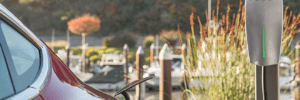
As EV adoption increases, we’re hearing a lot of news about bidirectional charging, which supports vehicle-to-grid (V2G) applications and other nifty stuff. In January, Wallbox announced what appears to be the first bidirectional charger for the home market. Fermata Energy has several V2X projects in the works, including a partnership with Nissan. And ORNL recently demonstrated bi-directional wireless charging, using a UPS delivery van.
Oddly, EV trendsetter Tesla has been mostly silent about V2G and its relatives, perhaps because of concerns about battery degradation, or because the company has been more interested in pushing its Powerwall stationary storage products.
In a recent filing with the Texas electric utility commission, Tesla seemed to relegate V2G to the list of future projects, implying that EV adoption had not yet reached the necessary scale, and that vehicle owners might not buy in to the technology.
However, Tesla does have a history of building in future-oriented hardware features, and keeping mum about them until it’s ready to implement them. Now Electrek reports that Tesla has quietly made Model 3, and presumably Model Y, ready for bidirectional charging.
Electrical engineer Marco Gaxiola reverse-engineered a Model 3’s onboard charger, and believes it to be bi-capable. “The design is fully bidirectional,” he told Electrek. “This means power can be converted from AC to DC…but also power can flow in reverse direction, coming from the battery and ending up on the AC side.”
“The bidirectional design is replicated 3 times across the same PCB on the Model 3 charger,” Gaxiola added. “Another example of redundant design that assures a working process even if one of the circuits fails. Additionally, it is 3-phase design, so it can be used worldwide.”
Viewers of EVTV may recall a similar revelation made by show host Jack Rickard back in December. After examining Model 3’s onboard charger hardware, Rickard said: “Now I’m not saying [Tesla is] going to do this without any changes to the hardware, but with enough time and a good compiler, I can make this thing take 400 V [DC] and put 240 V [AC] out the opposite end.”
(Bidirectional charging discussion begins around 16:30.)
Mr. Gaxiola believes that Tesla could enable Model 3’s V2G capability via an over-the-air software update. The necessary hardware seems to be contained within the vehicle, so bidirectional charging would not require a separate inverter such as Wallbox’s product.
As Electrek’s Fred Lambert notes, the implications are profound. Bidirectional charging offers not only the features associated with storage devices such as Tesla’s Powerwall (backup power for emergencies, storing power from solar panels to be used at night, etc). In the near future, it could allow EV owners to earn money by providing grid services to their local utilities (with Tesla taking a cut via its Autobidder software, of course). JB Straubel has previously pointed out that the million or so Teslas already on the road represent some 10 GW worth of storage capacity—in some regions, at least, that may be enough to attract the attention of utilities looking for storage assets.
Source: EVTV, Marco Gaxiola via Electrek
source https://chargedevs.com/newswire/are-teslas-models-3-and-y-already-capable-of-bidirectional-charging/

No comments:
Post a Comment